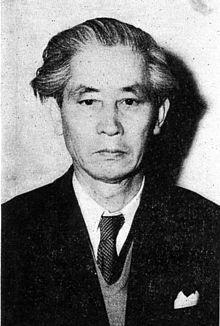Togo Murano
Tōgo Murano (村野 藤吾 Murano Tōgo?, May 15, 1891 – November 26, 1984) was a Japanese architect. Although his formative years were between 1910 and 1930, he remained active in design throughout his life and at the time of his death was responsible for over three hundred completed projects.
Although his work lacked a distinctive singular style he was recognised as a master of the modern interpretation of the sukiya style. His work included large public buildings as well as hotels and department stores and he has been recognised as one of Japan's modern masters.
After serving two years in a volunteer military corps Murano entered the Department of Electrical Engineering at Waseda University in 1913. In 1915 he transferred to the Architecture Department before graduating in 1918. Unlike his contemporaries, he moved from Tōkyō to Ōsaka and started work at the Kansai office of Setsu Watanabe. Murano spent eleven years at Watanabe's office learning all aspects of design and working on many large projects such as offices, commercial buildings and cultural facilities. In 1920 he was sent to America and Europe to further his knowledge and architectural vocabulary. In 1929 he left Watanabe to start his own office.
During the Taishō Period when culture in Japan became liberated for the first time from authority, culture became politicised and nationalistic overtones brought modernist architects into conflict with the state. The liberal Murano channelled this conflict into an interest into sukiya architecture which allowed him to balance tradition and modernisation in his work. Unlike his contemporary, Antonin Raymond, Murano courted simplicity, concentrating on the high arts like tea ceremony and conceptual elegance. As well producing many sukiya-style buildings, such as the Kasuien Annex to the Miyako Hotel in Kyoto, Murano used the sukiya style to incorporate Japanese tradition with borrowed elements of Western style. The emphasis of the sukiya style on surfaces, the juxtaposition of materials and elaborate details can be found in his work, for example, the mother-of-pearl encrusted ceiling of the Nihon Seimei Hibiya Building and Nissei Theatre in Tōkyō.
...
Wikipedia

